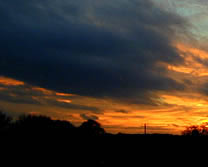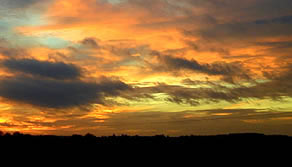
OPOD
What's New
Rays & Shadows
Crepuscular rays
Anti-crepuscular
Cloud shadows
Mountain Shadow
Earth's Shadow Blue Sky
Sunsets
Volcanic ash
Flattened Suns
Infrared sunset
More Images
Sunset Mirages
Green Flash Moonrise/set
Opposition effect
Water Droplets
Rainbows
Ice Halos
High Atmosphere
Links & Resources
Search - Index
123456789012345678

| Sunsets |
Sunset rays pass long and deep through the lower atmosphere. They are bent and twisted around the very rim of the Earth. The atmosphere acts as a giant lens which refracts low sunset rays into long curved paths passing through up to 40 times as much air than the rays from a high midday sun. Air, dust, aerosols and water drops scatter and absorb the rays throughout their long passage. Reds, yellows and golds arise because the air itself, small dust and aerosol particles smaller than the wavelengths of visible light, Rayleigh scatterers*, scatter short wavelength blue and green rays much more strongly than longer wavelength yellow and red. The remaining direct unscattered light is dimmed but relatively enriched in reds and yellows. Absorption of specific green and blue wavelengths by ozone and water vapour molecules redden the light further. The sunset rays are sometimes reflected back and forth between clouds and the ground. All this goes to makes a spectacle seemingly painted with every colour and shade of the palette. When the upper atmosphere contains extra fine dust from a volcanic eruption skies are reddened further. Large dust particles and suspended water droplets scatter light differently, they are Mie scatterers** and do not produce vivid red sunsets, they merely dim the sun. |
||||||||||||||||
*Rayleigh scatterers Particles much smaller than wavelengths of light scatter light in all directions. Their scattering is inversely proportional to the fourth power of the wavelength. Blue (~450 nanometer wavelength) is scattered over four times more strongly than red (~650 nm). Very small dust particles are Rayleigh scatterers. Some smoke particles are small enough also, watch smoke from a fire, it looks red or brown when viewed against a bright light but blue/white otherwise. **Mie scatterers Particles larger than visible wavelengths scatter light predominantly forwards in the direction of the original beam. Some, like water droplets, also scatter strongly in other quite specific directions to form rainbows, fogbows, glories and coronae. With the exception of these specific directions light of different wavelengths is scattered much more equally than by Rayleigh scatterers. |


